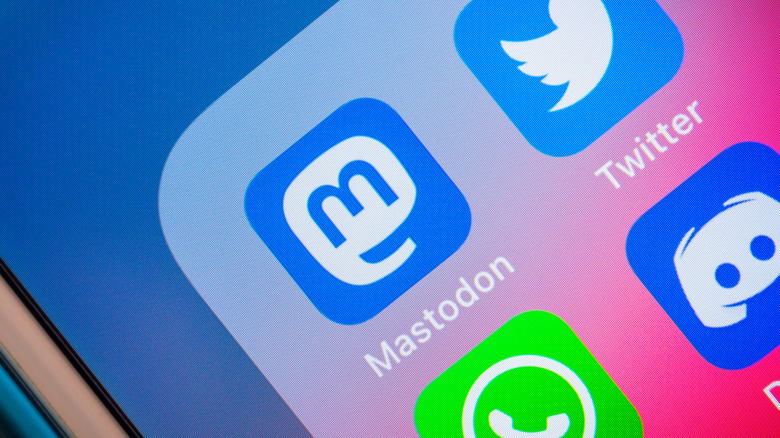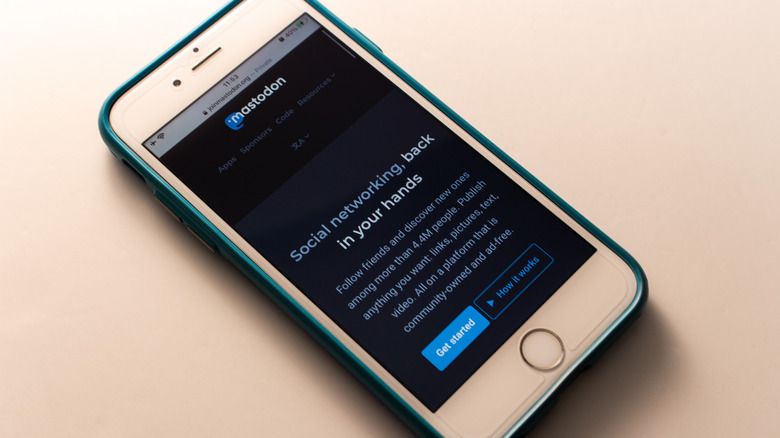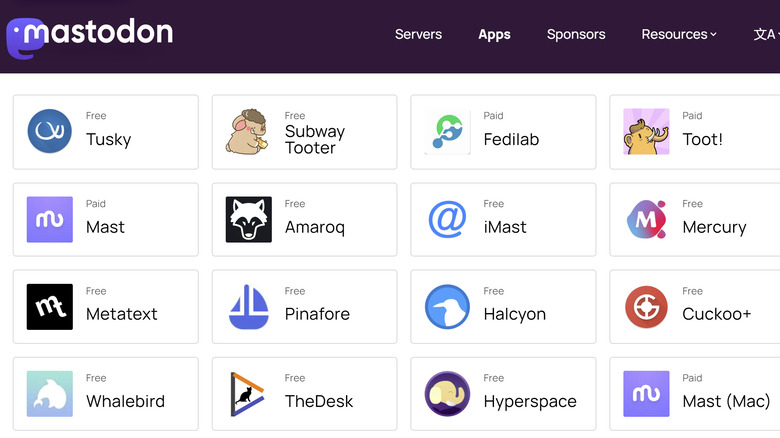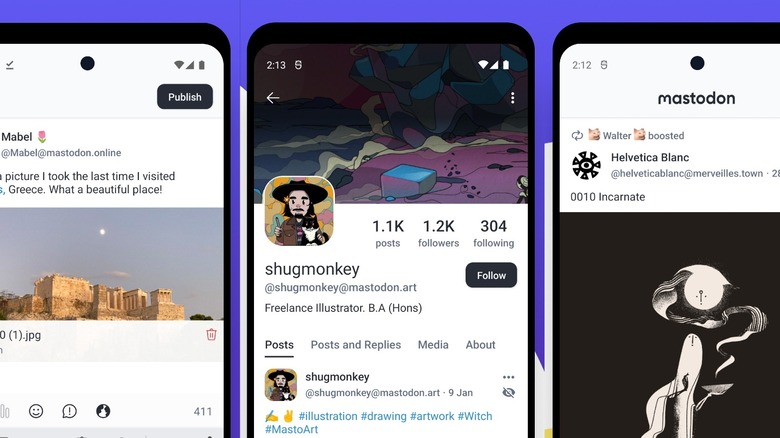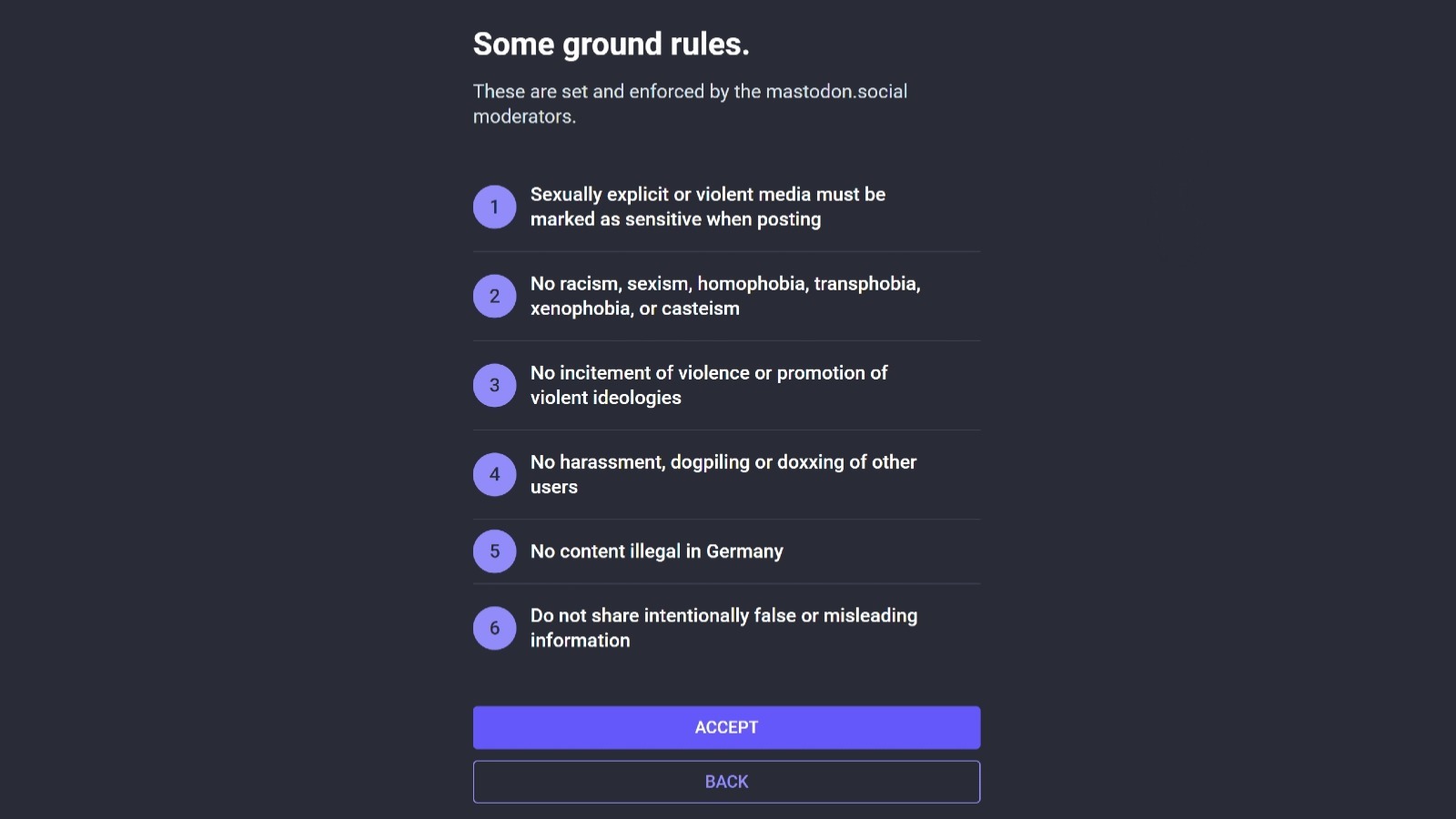What Is Mastodon, The Twitter Alternative?
With Elon Musk's takeover of Twitter, many users are ditching — or, at least threatening to ditch — their accounts in favor of an alternative. The reasons vary, but many users say their decision is due either to a personal dislike of Musk or worries that his so-called "free speech" plans for the platform may transform it into a toxic cesspool. Musk himself has expressed plans to mitigate that potential reality using new systems, such as potentially implementing a rating-based system so that users can get the kind of experience they're looking for.
It's too soon to say how Twitter's future will look, but in the meantime, it may be a good idea to get yourself established on a different platform just in case. Mastodon is one such option due to some of its similarities with Twitter, but the foundational technology behind it is very different and a tad confusing. What exactly is Mastodon and is it a suitable Twitter alternative? The answer is complicated.
What is Mastodon?
Mastodon is, at first glance, essentially a Twitter clone. The microblogging social media platform offers many of the same features found on Twitter, including the ability to mention other accounts, post content only visible to followers, and post content for the general public to see, plus there's support for sharing multimedia content like images, videos, and even creating polls. As well, Mastodon offers its users access to posts from their followers in a chronological news feed, which addresses one of the biggest gripes Twitter users have had with the latter platform in recent years.
The platform — which mostly waxes and wanes in popularity based on how people feel about Twitter at any given moment — differs from Twitter in a substantial way, however: it is a decentralized network, which means that communities have far more freedom to build their own little corners of the internet and moderate them as they see fit. Though these communities exist across a wide range of servers, Mastodon makes it possible for those servers to exist across a unified landscape, meaning that a Mastodon user can follow and see content from other users who are spread across multiple servers using a single account.
How does Mastodon work?
Mastodon is open source and free; users can access it through a large number of third-party mobile apps, some of them free and others paid, each offering an array of features so that there's a bit of something for everyone. Mastodon can also be accessed on desktop and even using a web browser on a mobile device, assuming you don't want to install an app. As well, anyone can start their own server — assuming they have the funds and know-how — and build a community on it, which offers a type of flexibility and a number of possibilities beyond what is available on Twitter.
Accounts are created on a server, though there's the option to move the account to a different server later on. Regardless, users are able to view content and interactions from users who created their accounts on a different server — assuming that instance is federated with others — so that despite its decentralized nature, Mastodon feels somewhat like a singular platform where everyone can participate. Many servers are created around particular topics, including ones for LGBTQ communities, technology, and even food, art, and music.
Most of the communities you can find on Twitter are also found on Mastodon — there are even multiple servers for furries, if you're into that sort of thing. At the time of writing, Mastodon says on its website that there are more than 3,000 servers on the network and more than 450,000 active monthly users, meaning there's no shortage of opportunities for interaction and engagement. That said, not every server is open to the public, and some require interested users to join a waitlist to (possibly) be granted future access to the communities.
Mastodon benefits
One of Mastodon's biggest benefits is its decentralized design. Because the fediverse is composed of many servers, users have the opportunity to find a group that interests them and that offers the type of experience they're looking for. Mastodon doesn't require users to isolate themselves in any single community, however. As such, Mastodon is flexible.
Because Mastodon is open source, any developer can create their own app for accessing the platform, so users aren't restricted to one official app and some unofficial ones that may be taken down or broken at any moment. Apps are available on all major platforms, including Android and iOS, plus there's even an option for SailfishOS. Android users, for example, can download Tusky for free or Fedilab if they're willing to pay for an app. iPhone users, meanwhile, have more options with things like Toot!, Mast, Amaroq, Mercury, iMast, and Metatext — two of them paid, and the rest available to download for free.
Each Mastodon server offers something different, so users who want a less moderated experience have the opportunity to find like-minded communities. The non-profit behind the platform explains that this locally-based moderation allows communities to run the way they think is best rather than requiring them to follow an overarching set of rules. Perhaps one of the best elements of Mastodon is its lack of advertisements, plus there are no algorithms deciding what you see (and don't see).
Mastodon negatives
Mastodon's decentralized nature and locally-based moderation are a double-edged sword. While offering communities more freedom when compared to Twitter, that means some servers are also quite toxic and include the kind of racist, sexist, and otherwise negative and hateful commentary and content you won't easily find on centralized big-name social media platforms. You'll simply have to avoid these online destinations, as there's no central company to appeal to in an attempt to get the content removed.
As well, the Mastodon experience may feel overwhelming initially due to the way servers — called instances or nodes — work as their own little islands. Each instance has its own feed of posts and depending on the software you're using to access the instance, it may feel clunky toggling between the streams of content across multiple instances.
Beyond that, the decentralized design means that it can be difficult for other people to find you on Mastodon, and that could prove particularly frustrating for many people. You can only follow and see content from users in other servers if those instances are federated with other instances. The platform has also been criticized for focusing too much on trying to clone Twitter, so much so that critics say it is limiting itself in a way that makes it less appealing. Case in point? The platform calls posts from users "toots," which is clearly a play on the term tweets, but one that is arguably terrible and that many users dislike.
How to use Mastodon
Because Mastodon is defined by an ocean of instances (servers), there's no singular place to sign up. Instead, you'll need to find a server that you find appealing and create an account on it. Arguably the most popular Mastodon instance is called mastodon.social, but there are many others to choose from. When you find one you like — assuming it allows anyone to join — getting on board with the platform is as easy as joining the server and creating your account. You can do this from your web browser, but if you prefer apps, you can download the official Mastodon app from the Google Play Store or the App Store — or, of course, download one of the other options mentioned above.
When you go to create your account, you'll see the rules enforced by that particular server — and as mentioned, these will vary between instances, so that what is acceptable on one node may not be acceptable on another. Using mastodon.social as an example, the instance forbids racism, sexism, homophobia, transphobia, and similar, doesn't allow its members to promote or call for violence, bans misinformation, and other things you'd commonly find on a mainstream social media platform.
After agreeing to the terms presented by a Mastodon server, you'll be able to enter your display name, which is the name that other users will see, as well as your username, which is what you'll use to log into the server. The username will be attached to the suffix "@mastodon.social," or whatever the name of the instance is, and you'll be able to use that as something akin to a URL for others to connect with you. You'll also need to provide your email address and create a password for the account.
